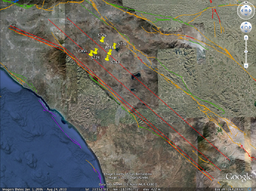Difference between revisions of "CyberShake PBR"
From SCECpedia
Jump to navigationJump to search| Line 12: | Line 12: | ||
*[[CyberShake]] | *[[CyberShake]] | ||
*[[Validation]] | *[[Validation]] | ||
| − | * | + | *[http://www.seismo.unr.edu/Faculty/2/ John Anderson UNR] |
Revision as of 20:29, 25 March 2011
Precarious Balanced Rocks (PBR) can be used to estimate peak strong ground motions over long periods of time. They provide important upper constraints on long-term probabilistic seismic hazard estimates.
CyberShake PBR
Standard PSHA provides long term peak ground motion estimates as single ground motion parameter such as peak ground acceleration. CyberShake provides a way to extend existing PSHA to provide more than peak ground motions. Through extended scientific HPC processing, CyberShake provides ground motion seismograms, together with peak ground motions values.
We are studying the effect of CyberShake seismograms on precarious rocks. To do this, we are gathering velocity profile information used in our CyberShake hazard calculations.
